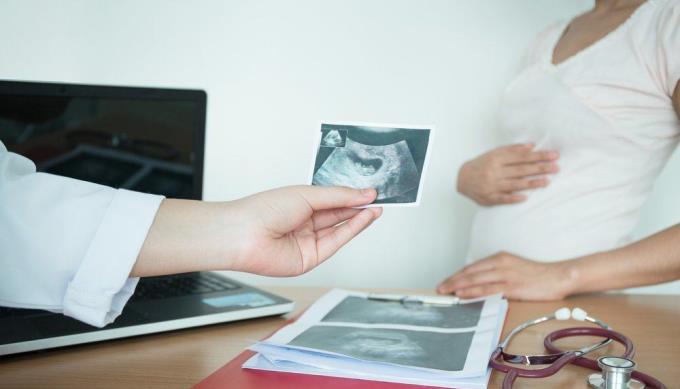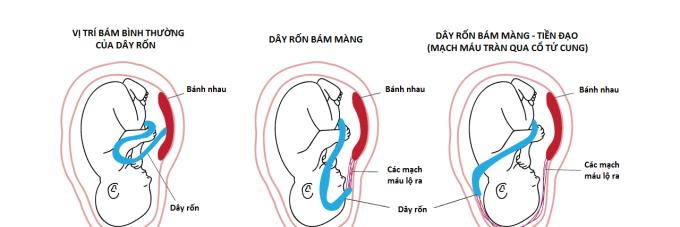The corded umbilical cord is a fairly rare umbilical cord abnormality that needs to be closely monitored throughout pregnancy. However, if there are appropriate measures, pregnant mothers will reduce the negative effects that this abnormal condition related to the umbilical cord causes on the health of both mother and fetus.
During pregnancy, the umbilical cord plays a very important role in connecting the fetus with the placenta. Therefore, any abnormality that occurs between the attachment of the umbilical cord to the placenta could put a pregnancy at a higher risk of complications.
What is umbilical cord?
During a normal pregnancy, fetal blood vessels run through the umbilical cord connecting directly between the mother's placenta. The membrane of the umbilical cord is when the fetal umbilical cord is abnormally inserted into the edge of the placenta along the placenta - amniotic fluid, causing the fetal blood vessels to function without the protection of the placenta until they form connected at the umbilical cord.
This uncommon pregnancy complication occurs in about 1% of single pregnancies and 15% of twins.
There is currently no clear explanation as to why umbilical cord attachment occurs. On the other hand, you will need to take care of this situation carefully to limit the bad risk of affecting your baby.
Diagnosis of umbilical cord membrane

A doctor may make a diagnosis of an umbilical cord attachment based on ultrasound images of the placenta and umbilical cord during the second and third trimesters. Some cases of this condition can be detected when pregnant women perform an ultrasound of the first trimester .
Who is at risk for this?
According to research, pregnant mothers are at risk of this condition when there is one of the following factors:
Pregnant mothers who have a striker placenta condition or a striker blood vessel have a higher risk of clinging together than normal.
Mothers expecting twins, who share chorionic also more at risk
Some studies suggest that this complication may be more common in in vitro fertilization
Pregnancy as you get older can increase your risk of developing the condition.
Is the umbilical cord lumpy and possible complications?
Complications due to the cord lining are fairly rare, but still dangerous.They include:
Compression or rupture of umbilical cord blood vessels: Enlargement of the umbilical cord leaves the umbilical cord blood vessels unprotected, putting them at greater risk of compression or rupture. This is especially likely when these vessels are located near the cervix.
Caesarean section: In case the umbilical cord is broken during labor increases the risk, pregnant mothers need urgent cesarean section.
Hemorrhage in labor: If you have an umbilical cord lining, you may experience bleeding problems during labor.
Does the umbilical cord affect the fetus?
Fortunately, the impact of this risk of pregnancy complications is very low, although this abnormal umbilical cord condition increases the risk of preterm birth, low Apgar scores and the infant. When born, need to stay in an intensive care unit.
In twin pregnancies with umbilical cord attached to the umbilical cord, both little angels are at risk of having their growth restricted.
What should pregnant mothers do?
If an ultrasound shows that you have had umbilical cord attached, you may need more frequent ultrasound to monitor the condition of the baby and placenta to ensure the pregnancy is developing safely. Specifically, the ultrasound examines the fetal anatomy in detail, see if there is a striker placenta, and assess the growth of the fetus.
In addition, you need to have a fetal cardiac measurement more often starting at 36 weeks, continuous measurement during birth to detect signs of umbilical cord compression and rupture of the striker blood vessels.
In case the readings are okay, experts recommend spontaneous labor for up to 40 weeks and normal vaginal delivery. The doctor will not need measures to urge fertility although pregnant women may go into labor before 40 weeks of pregnancy. There is no evidence to suggest that urging a caesarean section or caesarean section limits the risk and complications.

Measures to prevent umbilical cord membranes
Currently, there is no measure to prevent it because this is a condition that occurs without a clear reason in the development of the fetus .
What you can do is find out as soon as possible through routine prenatal check-ups and fetal ultrasound for timely follow-up measures.
You may be interested in the topic:
Young placenta
Umbilical cord wraps the fetus's neck: Is it dangerous as pregnant mothers think?
Low placenta: Signs, risks, and treatment













